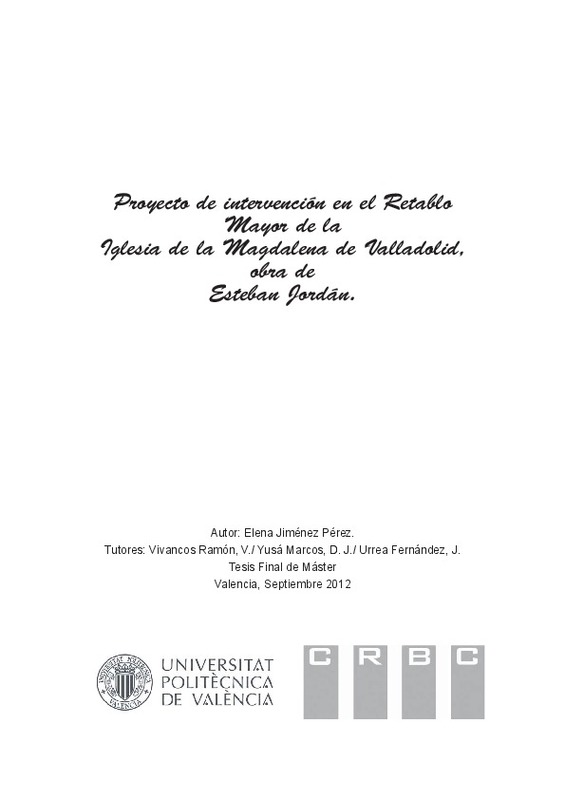|
Resumen:
|
[ES] El Retablo Mayor de la Iglesia de Santa María Magdalena de Valladolid es obra realizada por el prestigioso artista Esteban Jordán, entre 1571 y 1577. En este momento y, a lo largo de todo el último tercio del siglo ...[+]
[ES] El Retablo Mayor de la Iglesia de Santa María Magdalena de Valladolid es obra realizada por el prestigioso artista Esteban Jordán, entre 1571 y 1577. En este momento y, a lo largo de todo el último tercio del siglo XVI, triunfa, en España, una tendencia artística, conocida como manierismo romanista, que hunde sus raíces en Italia, concretamente en Miguel Ángel, siendo Jordán y la escuela de Valladolid, sus máximos representantes.
En este estudio, se realiza una breve revisión bibliográfica sobre el artista y su estilo, con el fi n de ahondar en su obra y proporcionar un conocimiento histórico y artístico básico sobre el retablo de la Magdalena, que es el tema principal de esta investigación. Establecidas las características artísticas y estilísticas del retablo, se realiza el análisis técnico y conservativo del mismo extrayendo muestras del original que han servido para establecer un primer contacto con los materiales constituyentes de la obra, válidos para efectuar test químicos más específicos que permitan confirmar (o validar) las hipótesis ahora planteadas.
Otra dimensión importante de este análisis es la formulación de una propuesta de intervención, con vistas a que en un futuro no muy lejano se decida restaurar el retablo. Con tal fi n, se efectuaron algunas catas en la zona de su banco para determinar qué tratamientos serían los más idóneos a la hora de acometer la restauración.
La tesina se apoya en un amplio reportaje fotográfico, aunque la imposibilidad de disponer de un andamio al pie del retablo ha impedido elaborar un estudio completo y preciso del mismo, que esperamos ir completando en futuros trabajos, mejorando la información aquí aportada.
[-]
[EN] The Altarpiece of the Santa Maria Magdalena church in Valladolid, was realized by the prestigious sculptor Esteban Jordán, in the period between 1571 and 1577.In that time and all along the last tier of XVI century, ...[+]
[EN] The Altarpiece of the Santa Maria Magdalena church in Valladolid, was realized by the prestigious sculptor Esteban Jordán, in the period between 1571 and 1577.In that time and all along the last tier of XVI century, the artistic tendency known as roman mannerism was very popular in Spain. This artistic tendency has its roots in Italy, more specifically in Michelangelo Buonarrotti, being Esteban Jordán and the school of Valladolid the main representants of this tendency in Spain.
In this study, we present a bibliographic review about the artista and his style, aiming to deep in the knowledge of his work of art, providing the basic knowledge, both historic and artistic, about the altarpiece of Santa Maria Magdalena, main topic of this research work. Once the artistic and estilistic characteristics the altarpiece have been established, a technical and conservation analysis is carried out. Test tubes were extracted from the original in order to establish a preliminary contact with the constituent materials; the test tubes will be used for the chemical analysis necessary to validate the hypotheses presented in the research work.
Another important dimension of this study consists of the formulation of a proposal of intervention in view of a future, hopefully soon, altarpiece restoration. Aiming to this, some test tubes were extracted from the new zone in order to determine the idoneous treatments for the future intervention.
This work is supported by a large photographic illustrated feature, even if the impossibility of installing an
scaffolding in the altarpiece has difficult the elaboration of an exhaustive illustrated feature, which we expect to complete in future works, in which we intend to improve the information supplied in this work.
[-]
|







